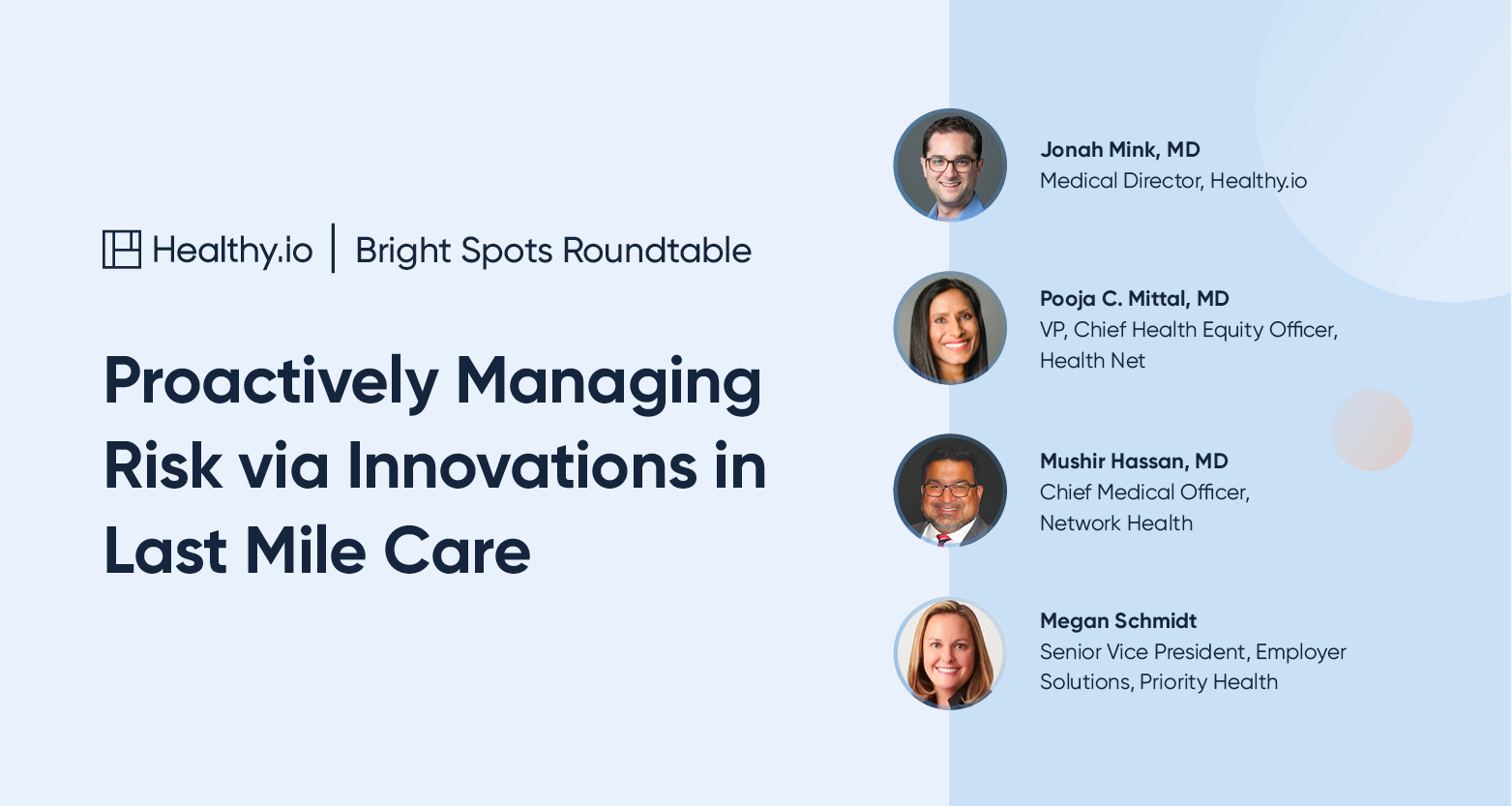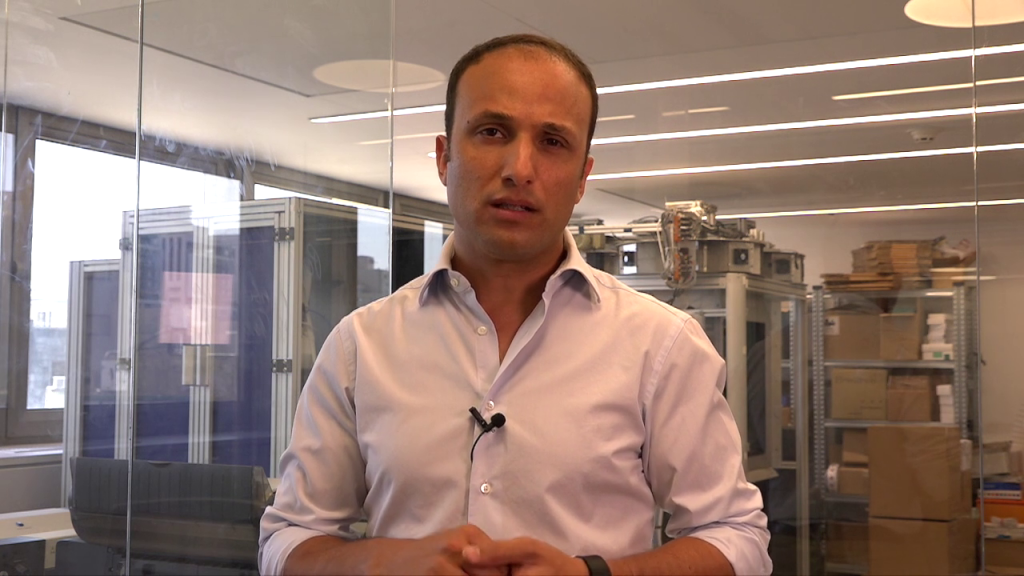With 60% of American adults living with a chronic disease, population-wide risk stratification has never been more important to health plans. But multiple barriers prevent members from doing the tests that allow for early detection of disease and preventive treatment. To engage with their at-risk members and meet them where they are, health plans must now deploy innovative technologies and strategies.
Healthy.io and Bright Spots in Healthcare recently held a roundtable discussion between healthcare leaders who shared their first-hand experiences and best practices for engaging with members to improve risk assessment and health outcomes. The event was hosted by Eric Glazer, CEO of Shared Purpose Connect, and featured speakers from Health Net, Network Health, Priority Health, and Healthy.io.
Here are some of the event’s many highlights:
Engaging members at home
During the pandemic, Network Health, a provider-owned health plan from Wisconsin, gained valuable experience reaching members at home, particularlyfor diabetes management and HPV testing. “I think that we’ve been able to build a track record where information and communication is well received by our members because we take a personalized approach,” said Dr. Mushin Hassan, Chief Medical Officer at the organization. “You can have technologies that people want to use, but engagement comes from having a local health plan and being able to build up trust with your membership so people will pay attention to what you send them.”
One pandemic-era initiative was designed to help seniors feel less lonely, and to help educate them on health-related matters, by supplying seniors them with tablets. The program was a success, but when asked following the pandemic whether they wanted to keep the tablets, most members said they’d prefer to go back to using what they already use: their smartphones. “The reality is, if you want to reach your members, find out what they’re using regularly,” Dr. Hassan said. “For us, using text messaging is probably the best way to reach our members and to ensure ongoing engagement.”
Creating value across the health spectrum
For health care solutions to be sustainable, they should be valuable to all parties involved: plans, members and clinicians. “If it can be reinforced by the clinician, that’s going to be the engine that can keep it running,” said Dr. Jonah Mink, Chief Medical Officer at Healthy.io.
“As a family doctor, what would I rather do? Would I rather be told to go find a person and call them in for an ACR test, when no one wants to go to the lab and pee in a cup, or would I rather get the result and be able to engage with my patient with an actionable result? Now I can treat my patient and have a conversation about risk. Now the plan knows about risk, the doctor knows about risk, the patient knows about risk—and everyone is deriving value.”
Jonah Mink, MD
Culture matters
The ways in which culture can affect people’s health and wellbeing are as diverse as culture itself. Dr. Pooja Mittal, the Chief Health Equity Officer for Health Net, a three million member-strong plan in California, demonstrated the need to analyze the particulars of different cultures with a striking example. “We noticed that there was an area in one of our counties with a group of women with very low postpartum follow-up rates,” she said. After further research, they found that the source was a clinic with a very high percentage of Salvadoran women, who have a postpartum tradition of quarantining at home for forty days after delivery. “Providers weren’t aware of this tradition and weren’t accounting for it when they were counseling people about postpartum care,” she said.
An ad hoc group of providers, community representatives and plan members came together to brainstorm ways to improve communication. They decided to create materials to educate the community about the importance of postpartum care, as well as adding a question about the quarantine tradition in the EMR so that providers would know to discuss it with relevant members. “Through this intervention, we were able to improve postpartum care rates in that population from 50% to 82% over the course of the year,” Dr. Mittal said. “This mirrors a lot of the work that we do at Health Net, which is geography-based and population-based. We come into a community and try and figure out what its strengths are and how we can use our data and support to improve the disparities that we see.”
Getting the right data
Comprehensive risk stratification requires data. But as Dr. Mink observed, “you only have so many data inputs that you can get from a patient before they get overwhelmed, before they feel like they’re working for you instead of you working for them.” Balancing the need for data with a patient-centric approach entails strategically the highest yield data points. “You want to find the biomarkers and measurements that are most closely correlated to risk, morbidity, mortality, and cost,” he said.
Healthy.io’s Minuteful Kidney measures the urine albumin-to-creatinine ratio (ACR). “It’s highly and independently correlated with cardiovascular morbidity and mortality, progression to end stage renal disease and death,” Dr. Mink said. “ACR is a very high yield metric. And adherence to it is very low.” The key is finding the right intervention to motivate people to complete the tests that provide the best data—in the case of Minuteful Kidney, allowing people to test from home using their smartphone.
One size does not fit all
Health plans produce large amounts of data every day, creating enormous potential for personalization that too often remains untapped. “I think that we’ve failed sometimes by taking a one size fits all approach, one program that’s going to meet the needs of everyone,” said Megan Schmidt, Sr. Vice President of Employer Solutions at Priority Health, the Michigan-based health plan with over one million members. Better to use the vast quantities of data produced daily to allow for personalizing programs and interventions to meet people where they are and help them engage with their care.
Personalization plays an important role in fostering a connected member experience, something Ms. Schmidt termed “an environment of connectedness”. By providing members with access to remote care technology they can use from home, and connecting them with clinical teams who are given real-time information to avoid silos of care, her organization has seen significant readmission avoidance and ER and urgent care reduction. “We know that when we’re keeping people with access to care and making sure they’re getting the care that they need, that we’re also giving them that triple aim,” she said. “Right care at the right place at the right time.”
For more insights from the event, watch the video recording below or listen to the podcast version on Apple Podcasts, Spotify, or Google Podcasts.






